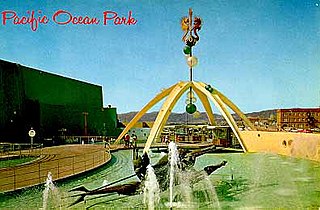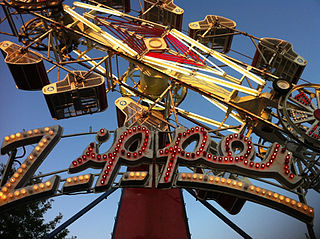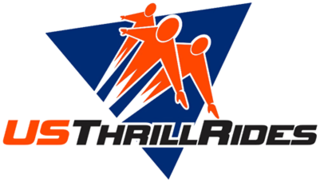
An amusement park is a park that features various attractions, such as rides and games, as well as other events for entertainment purposes. A theme park is a type of amusement park that bases its structures and attractions around a central theme, often featuring multiple areas with different themes. Unlike temporary and mobile funfairs and carnivals, amusement parks are stationary and built for long-lasting operation. They are more elaborate than city parks and playgrounds, usually providing attractions that cater to a variety of age groups. While amusement parks often contain themed areas, theme parks place a heavier focus with more intricately-designed themes that revolve around a particular subject or group of subjects.

Lagoon is a privately owned amusement park in Farmington, Utah, United States, located about 18 miles north of Salt Lake City. It has ten roller coasters, five of which are unique; Colossus the Fire Dragon, the last Schwarzkopf Double Looping coaster still in operation in the United States ; Roller Coaster, one of the oldest coasters in the world operating since 1921; Wicked, designed by Lagoon's engineering department and Werner Stengel in cooperation with ride manufacturer Zierer; BomBora, a family coaster designed in-house; and Cannibal, built in-house with one of the world's steepest drops.

Luna Park Sydney is a heritage-listed amusement park located at 1 Olympic Drive in the harbourside suburb of Milsons Point, New South Wales, Australia, on the northern shore of Sydney Harbour. The amusement park is owned by the Luna Park Reserve Trust, an agency of the Government of New South Wales, and was added to the New South Wales State Heritage Register on 5 March 2010.

Pacific Ocean Park was a 28-acre (11-hectare), nautical-themed amusement park built on a pier at Pier Avenue in the Ocean Park section of Santa Monica, California. Intended to compete with Disneyland, it replaced Ocean Park Pier (1926-1956). After it closed and fell into disrepair, the park and pier anchored the Dogtown area of Santa Monica.
Luna Park Melbourne is a historic amusement park located on the foreshore of Port Phillip Bay in St Kilda, Melbourne, Victoria. It opened on 13 December 1912, with a formal opening a week later, and has been operating almost continuously ever since.

Tilt-A-Whirl is a flat ride similar to the Waltzer in Europe, designed for commercial use at amusement parks, fairs, and carnivals, in which it is commonly found. The rides are manufactured by Larson International of Plainview, Texas.
The Gravitron is an amusement ride, most commonly found as a portable ride at fairs and carnivals. The Gravitron first appeared at Morey's Piers in 1983 and quickly became a fixture at amusement parks in many countries. It is a modification of an earlier ride called the Rotor. The ride was originally designed and manufactured by Wisdom Industries.

The Zipper is an amusement ride invented by Joseph Brown under Chance Rides in 1968. Popular at carnivals and amusement parks in the United States, Canada, Australia, Mexico and New Zealand, it features strong vertical G-forces, numerous spins, and a noted sense of unpredictability. Chance Rides has manufactured more than 200 units since the ride's debut.

A funhouse or fun house is an amusement facility found on amusement park and funfair midways in which patrons encounter and actively interact with various devices designed to surprise, challenge, and amuse the visitor. Unlike thrill rides, funhouses are participatory attractions, where visitors enter and move around under their own power. Incorporating aspects of a playful obstacle course, funhouses seek to distort conventional perceptions and startle people with unstable and unpredictable physical circumstances within an atmosphere of wacky whimsicality.
Calaway Park is an amusement park and campground in Springbank, Alberta, Canada. The park occupies approximately 160 acres (65 ha) of land, although the amusement park only occupies 90 acres (36 ha) of it. The park is western Canada's largest amusement park, and is situated approximately 4 kilometres (2.5 mi) west of Calgary's city limits.

Conklin Shows was the largest traveling amusement corporation in North America. The 75-year-old company operated traveling carnivals at various summer agricultural shows across North America and is based in Brantford, Ontario and formerly also in West Palm Beach, Florida. The company has a long history in Canada, providing entertainment for generations of children and adults. The organization used to operate the midway services for some of Canada's largest summer fairs including the Canadian National Exhibition in Toronto, the Calgary Stampede, and Edmonton's K-Days. In 2004, Conklin Shows International route and equipment were sold to North American Midway Entertainment.

A Music Express is an amusement ride based on the original Caterpillar rides of Germany. Several near-identical ride designs are also produced by other companies: Musik Express by Italian company Bertazzon and US Majestic Rides, Himalaya by American company Wisdom Rides, German company Mack, and French company Reverchon, and Silver Streak by Wisdom Rides. This ride is a modern adaptation of the famous Harry Traver Caterpillar rides.

The Myrtle Beach Pavilion was a historic pay-per-ride, no parking fee, 11-acre amusement park that was located in Myrtle Beach, South Carolina at the corner of 9th Avenue North and Ocean Boulevard. It was just a few blocks down from another Myrtle Beach amusement park, the Family Kingdom Amusement Park; both in the "heart" of Myrtle Beach. "The Pavilion" had well over 40 different attractions for kids and thrill-seekers alike, and included the wooden rollercoaster Hurricane: Category 5. Despite all the best efforts made by citizens to save the park, it was lost to redevelopment in 2007. While the park was officially closed and became a vacant lot on 9th Avenue and Ocean Boulevard in 2007, some of the rides and attractions were moved to Broadway at the Beach. Broadway at the Beach and the land at 9th Avenue are both owned by Burroughs & Chapin.

The Rock-O-Plane is an amusement park ride designed by Lee Eyerly in 1948 and manufactured by the Eyerly Aircraft Company of Salem, Oregon.

Bumper boats are an amusement park ride that uses inner tube shaped watercraft that can be steered by the rider. Some are driven by electric motors, some by gasoline engines, and some require the rider to propel the craft by pedaling. Most are equipped with water guns for duels with other riders. Bumper boat attractions can commonly be found in places such as amusement parks, carnivals, fairs, family fun centers, and theme parks.

The Wipeout and Trabant are models of amusement rides manufactured by Chance Rides. Often seen at fairs and traveling carnivals, their design consists of a giant wheel which tilts at a steep angle, fluctuates in a wavelike manner, and spins at various speeds. There is a motor underneath the ride that makes both of these rides raise up and down.

A traveling carnival, usually simply called a carnival, or travelling funfair is an amusement show that may be made up of amusement rides, food vendors, merchandise vendors, games of chance and skill, thrill acts, and animal acts. A traveling carnival is not set up at a permanent location, like an amusement park or funfair, but is moved from place to place. Its roots are similar to the 19th century circus with both being fitted-up in open fields near or in town and moving to a new location after a period of time. In fact, many carnivals have circuses while others have a clown aesthetic in their decor. Unlike traditional carnival celebrations, the North American traveling carnival is not tied to a religious observance.

Fiesta Shows is a travelling amusement park that entertains and visits over 60 communities throughout the New England region. It is New England's largest carnival.

US Thrill Rides is an entertainment design and consulting company in Orlando, Florida. It is best known for creating thrill rides and roller coasters worldwide.
Eyerly Aircraft Company was an amusement ride manufacturing company in Salem, Oregon, founded by Lee Eyerly in 1930. The company originally intended to design flight simulators for the aircraft industry but shifted to amusement rides after an early simulator, called Orientator, became a popular pay-per-ride attraction with the public. The company manufactured rides until 1985 and went bankrupt in 1990, following a fatal accident in 1988 that occurred on a ride built by the company.















